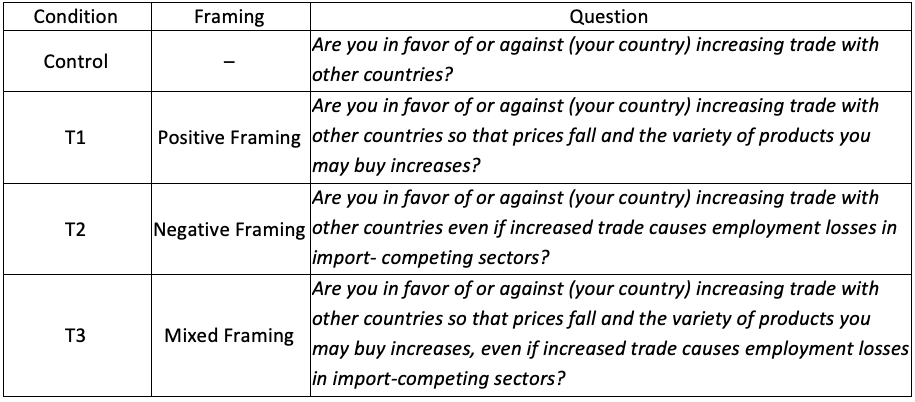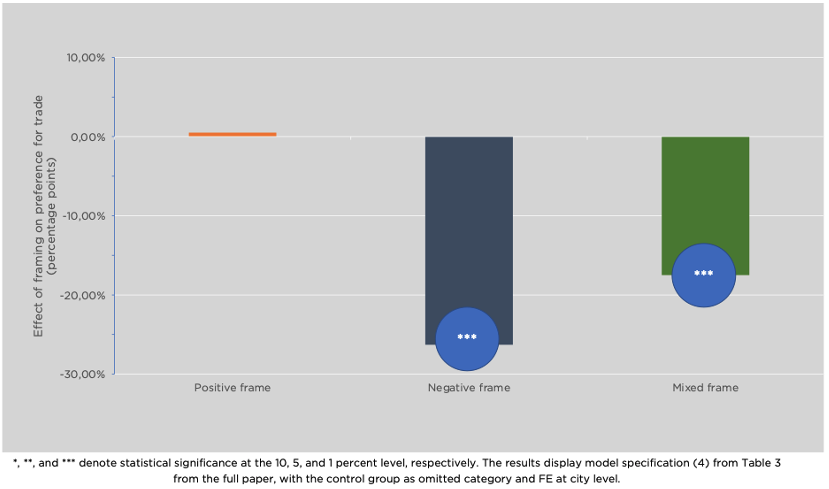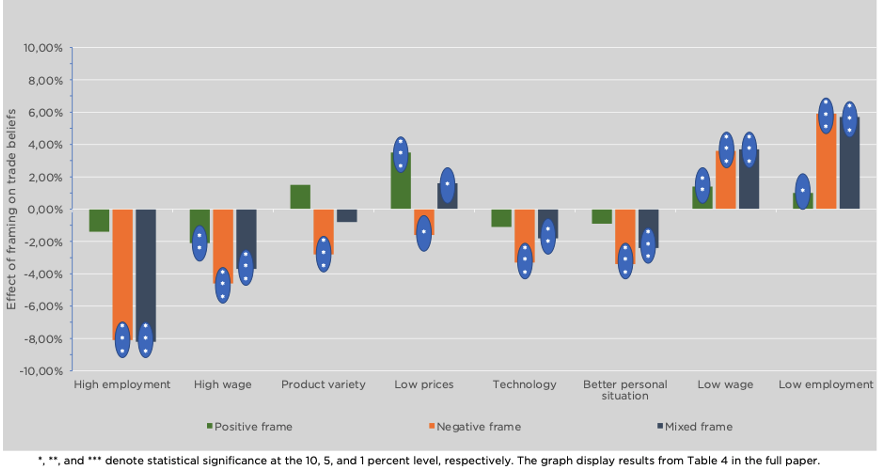How issue framing shapes trade attitudes

Context
In recent years, trade policies have received renewed public attention. While trade should have positive aggregate welfare effects, the distribution of benefits within the labor market varies. Some political campaigns in developed countries have used these inherent distributive tensions to demand swift changes to national trade policies. Political attention notwithstanding, the role of citizens’ preferences on trade has remained largely unexplored. Notably, there is little knowledge of how beliefs shape policy preferences on trade and how issue framing around trade determines those preferences. A better understanding of the interplay between framing, preferences, and beliefs could advance our understanding of the trade policy outcomes we currently observe.
The Project
IDB researchers implemented an experiment as part of the Latinobarómetro 2018 that explored trade preferences and beliefs in Latin America. The behaviorally-informed component tested how framing questions on trade in different ways might impact an individual’s trade preferences. The study further explored how beliefs help to explain preferences and heterogeneous effects of trade preferences in regard to country or level of education. To the best of the authors' knowledge, this is the first survey experiment on trade with a representative sample for a large number of countries.
Behavioral Analysis
Behavioral Barriers
Lack of information: People may lack relevant information, for instance, because information is difficult to obtain, scarce, or hard to understand. This problem informs policy preferences on trade.
Loss aversion: Refers to the idea that a loss causes distress that is greater than the happiness caused by a gain of the same size. Citizens might form anti-trade preferences when information emphasizes potential losses that weigh stronger than information underscoring potential benefits.
Limited attention: Even when the relevant information is in principle available, people’s ability to process information is limited. As a result, they may ignore relevant pieces of information unless that information is communicated clearly and simply. In this context, citizens might not be able to dedicate significant attention to processing information about trade and its potential impact on their everyday lives.
Inertia and status quo bias: People may be attached to the status quo of affairs and dread or overestimate the costs of taking action, despite actual or perceived benefits. The current trade policy might be preferred because it has been the status quo for a certain period of time.
Behavioral Tools
Framing effect: The tendency to draw different conclusions depending on how information is presented. For example, options can be presented in a way that highlights the positive or negative aspects of a decision, leading an option to be perceived as more or less attractive. In this context, information on trade was presented in different frames with positive, negative, or mixed aspects highlighted.
Salience: Applies both to things that stand out and things that cease to stand out. Individuals tend to focus on points and information that stand out and ignore those that do not; this is also called shiny object bias. In this study, the treatment conditions made different aspects of trade more salient.
Intervention Design
This study was included as one module into the Latinobarómetro survey, which obtained data between June and August 2018. The Latinobarómetro is a representative survey of adult citizens from 18 Latin American countries. The overall sample size was 20,204. Nearly all participants were interviewed at their homes, and data were recorded either on paper or on electronic devices. Other modules of the survey elicit preference on a diverse range of topics and on participants’ socio-economic data.
In the first part, the experiment made use of different framing prompts to test how different informational frames might impact citizens’ trade preferences. The underlying theory of change assumed that different framings might lead to stronger or weaker preferences for trade. All participants were randomly assigned to one of four conditions. Besides one control group, the three treatments presented a positive framing (T1), a negative framing (T2), and a mixed framing (T3) (see Table 1). Answers within each condition were binary (“In favor of”; “Against”).
Table 1. Experimental Conditions.

After the treatment exposure, participants were asked to select, from among eight overall beliefs describing possible consequences of increased trade, those with which they agreed. They included “Higher employment,” “Higher wages,” “Product variety,” “Lower prices,” “Access to technology,” “Better personal economic situation,” “Lower wages,” and “Lower employment.”
The main form of data analysis took the form of an OLS regression with the control group as excluded category and coefficients for each treatment indicating the average treatment effect.
Challenges
- The question eliciting trade preference was intentionally formulated broadly, informed by previous research on framing. However, it might be possible that the specific wording is seldom used in political contexts and might trigger different answers than more frequent formulations involving “import,” “export,” etc.
- Results indicated potential issues in implementing the experiment in the Dominican Republic, as no or only very small effects of framing were discernible at all.
Results
- Framing effects strongly affect trade preferences. The share of participants with preferences for trade was 73.11 percent in T1 (Positive frame), 72.64 percent in the control group, 46.33 in T2 (Negative frame), and 55.10 percent in T3 (Mixed frame).
- For the model specification with fixed effects on the city level, the treatment effect for the positive frame is small and statistically insignificant. The treatment effect for T2 is large, negative, and highly significant. It decreased trade preferences by about 26 percentage points (pp). For T3, results are equally negative and highly significant, indicating an approximately 17 pp reduction of trade support. The latter results indicate potential interactions between positive and negative framing, with negative information having a greater impact. Information. This finding is in line with research in loss aversion (Figure 1).
- Framing effects also seemed to have impacted beliefs. For T1, beliefs on product variety and low prices were strengthened, which is in line with the information presented in this condition. In contrast, the six other beliefs were negatively impacted across all three frames. For instance, the negative frame reduced beliefs that trade increases employment by over 8 pp and the belief that it might increase wages by 4.5 pp (Figure 2).
- Regression analysis of trade preferences on trade beliefs indicates that negative beliefs (low wages, low employment) are always associated with lower trade support, while the same holds true for positive beliefs (high wages, high employment, product variety, low prices).
- The study also elicits heterogenous effects across various variables. Countries range from about 60 (Argentina, Peru) to over 85 percent approval for trade (Venezuela, Honduras, Uruguay, Nicaragua); finally, individuals who are more educated are more supportive of trade but also more sensitive to framing effects.
Figure 1. Effect of Framing on Trade Preferences.

Figure 2. Effect of Framing on Trade Preferences.

Policy Implications
- The study replicated previous results that emphasize the importance of informational frames in determining citizens’ policy preferences. For policymakers, this implies a) the importance of validating policy messages across different wordings and b) the need to be diligent and careful in wording messages about policy in general.
- Heterogenous effects of education might help to better understand trade policy outcomes. Since highly educated people are more likely to influence and determine policy outcomes on trade, their sensitivity to negative frames is likely to play a more prominent role when countries navigate a course that is rather antagonistic to increased trade.
